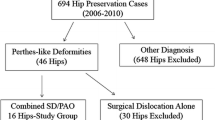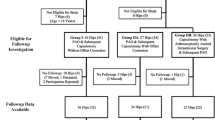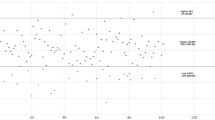Abstract
Background
Perthes-like hip deformities encompass variable proximal femoral abnormalities and associated acetabular dysplasia that can be reconstructed with contemporary hip preservation procedures. Nevertheless, the necessity and indications for surgical correction of associated acetabular dysplasia have not been established.
Questions/Purposes
We determined whether patient-specific factors (sex, age, BMI, previous surgery, hip pain and function) and/or structural deformity characteristics (radiographic parameters of acetabular morphology) were associated with our indications for acetabular reorientation in surgical reconstruction of Perthes-like hip deformities.
Methods
We compared patient-specific characteristics and radiographic parameters of acetabular morphology in 94 patients (97 hips) with residual Perthes deformities who underwent joint preservation surgery without or with a periacetabular osteotomy (PAO) as part of the reconstruction.
Results
Patient sex, BMI, preoperative Harris hip score, and previous hip surgery were not associated with our indications for a combined femoral and PAO procedure. Radiographic parameters associated with the indication for a PAO included the lateral center-edge angle, anterior center-edge angle, acetabular inclination, and acetabulum-head index. No or mild secondary osteoarthritis and joint congruency were associated with the indication for a PAO as part of the reconstruction.
Conclusions
Contemporary hip preservation surgery for residual Perthes deformities covers a wide spectrum of procedures. We believe a PAO should be considered in the surgical treatment plan for symptomatic patients having radiographic parameters indicating acetabular dysplasia, no or mild secondary osteoarthritis, and adequate joint congruity.
Level of Evidence
Level III, prognostic study. See Instructions for Authors for a complete description of levels of evidence.


Similar content being viewed by others
References
Anderson LA, Erickson JA, Severson EP, Peters CL. Sequelae of Perthes disease: treatment with surgical hip dislocation and relative femoral neck lengthening. J Pediatr Orthop. 2010;30:758–766.
Aronson J. Osteoarthritis of the young adult hip: etiology and treatment. Instr Course Lect. 1986;35:119–128.
Beck M, Mast JW. The periacetabular osteotomy in Legg-Perthes-like deformities. Semin Arthroplasty. 1997;8:102–107.
Bowen JR, Kumar VP, Joyce JJ 3rd, Bowen JC. Osteochondritis dissecans following Perthes’ disease: arthroscopic-operative treatment. Clin Orthop Relat Res. 1986;209:49–56.
Byrd JW, Jones KS. Hip arthroscopy in the presence of dysplasia. Arthroscopy. 2003;19:1055–1060.
Catterall A, Pringle J, Byers PD, Fulford GE, Kemp HB, Dolman CL, Bell HM, McKibbin B, Ralis Z, Jensen OM, Lauritzen J, Ponseti IV, Ogden J. A review of the morphology of Perthes’ disease. J Bone Joint Surg Br. 1982;64:269–275.
Clohisy JC, Carlisle JC, Beaule PE, Kim YJ, Trousdale RT, Sierra RJ, Leunig M, Schoenecker PL, Millis MB. A systematic approach to the plain radiographic evaluation of the young adult hip. J Bone Joint Surg Am. 2008;90(suppl 4):47–66.
Clohisy JC, Nunley RM, Curry MC, Schoenecker PL. Periacetabular osteotomy for the treatment of acetabular dysplasia associated with major aspherical femoral head deformities. J Bone Joint Surg Am. 2007;89:1417–1423.
Ganz R, Gill TJ, Gautier E, Ganz K, Krugel N, Berlemann U. Surgical dislocation of the adult hip: a technique with full access to the femoral head and acetabulum without the risk of avascular necrosis. J Bone Joint Surg Br. 2001;83:1119–1124.
Harris WH. Etiology of osteoarthritis of the hip. Clin Orthop Relat Res. 1986;213:20–33.
Herring JA, Kim HT, Browne R. Legg-Calvé-Perthes disease. Part I. Classification of radiographs with use of the modified lateral pillar and Stulberg classifications. J Bone Joint Surg Am. 2004;86:2103–2120.
Heyman CH, Herndon CH. Legg-Perthes disease; a method for the measurement of the roentgenographic result. J Bone Joint Surg Am. 1950;32:767–778.
Jamali AA, Mladenov K, Meyer DC, Martinez A, Beck M, Ganz R, Leunig M. Anteroposterior pelvic radiographs to assess acetabular retroversion: high validity of the “cross-over-sign.” J Orthop Res. 2007;25:758–765.
Jonsater S. Coxa plana; a histo-pathologic and arthrografic study. Acta Orthop Scand Suppl. 1953;12:5–98.
Kuklo TR, Mackenzie WG, Keeler KA. Hip arthroscopy in Legg-Calvé-Perthes disease. Arthroscopy. 1999;15:88–92.
Lequesne M, de Seze S. [False profile of the pelvis: a new radiographic incidence for the study of the hip. Its use in dysplasias and different coxopathies] [in French]. Rev Rhum Mal Osteoartic. 1961;28:643–652.
McAndrew MP, Weinstein SL. A long-term follow-up of Legg-Calvé-Perthes disease. J Bone Joint Surg Am. 1984;66:860–869.
Medlock V, Rathjen KE, Montgomery JB. Hip arthroscopy for the late sequelae of Perthes disease. Arthroscopy. 1999;15:552–553.
Mose K, Hjorth L, Ulfeldt M, Christensen ER, Jensen A. Legg Calvé Perthes disease: the late occurence of coxarthrosis. Acta Orthop Scand Suppl. 1977;169:1–39.
Myers SR, Eijer H, Ganz R. Anterior femoroacetabular impingement after periacetabular osteotomy. Clin Orthop Relat Res. 1999;363:93–99.
Novais EN, Clohisy J, Siebenrock K, Podeszwa D, Sucato D, Kim YJ. Treatment of the symptomatic healed Perthes hip. Orthop Clin North Am. 2011;42:401–417, viii.
Omeroglu H, Ucar DH, Tumer Y. [A new measurement method for the radiographic assessment of the proximal femur: the center-trochanter distance] [in Turkish]. Acta Orthop Traumatol Turc. 2004;38:261–264.
Roy DR. Arthroscopic findings of the hip in new onset hip pain in adolescents with previous Legg-Calvé-Perthes disease. J Pediatr Orthop B. 2005;14:151–155.
Sankar WN, Flynn JM. The development of acetabular retroversion in children with Legg-Calvé-Perthes disease. J Pediatr Orthop. 2008;28:440–443.
Shore BJ, Novais EN, Millis MB, Kim YJ. Low Early Failure Rates Using a Surgical Dislocation Approach in Healed Legg-Calve-Perthes Disease. Clin Orthop Relat Res. 2011 November 29 [Epub ahead of print].
Suzuki A, Kasahara Y, Seto Y, Futami T, Furukawa K, Nishino Y. Arthroscopy in 10 children with perthes disease: pathologic changes of the synovium and the joint surface. Acta Orthop Scand. 2004;66:581–584.
Tönnis D. Congenital Dysplasia and Dislocation of the Hip in Children and Adults. Berlin, Germany: Springer; 1987.
Wiberg G. Studies on dysplastic acetabula and congenital subluxation of the hip joint: with specific reference to the complication of osteoarthritis. Acta Chir Scand. 1939;83(suppl 58):5–135.
Acknowledgments
We thank Debbie Long for assistance with the preparation of this manuscript.
Author information
Authors and Affiliations
Corresponding author
Additional information
The institution of one or more of the authors (JJN) has received, during the study period, funding from Arthrex Hip Anatomical Study. The institution of one or more of the authors (JCC) has received, during the study period, research support from Zimmer, Inc (Warsaw, IN, USA) and the Curing Hip Disease Fund (St Louis, MO, USA). One of the authors (JCC) certifies that he, or a member of his immediate family, has received or may receive payments or benefits, during the study period, an amount less than $10,000, from Biomet Inc (Warsaw, IN, USA).
All ICMJE Conflict of Interest Forms for authors and Clinical Orthopaedics and Related Research editors and board members are on file with the publication and can be viewed on request.
Each author certifies that his or her institution approved the human protocol for this investigation, that all investigations were conducted in conformity with ethical principles of research, and that informed consent for participation in the study was obtained.
About this article
Cite this article
Clohisy, J.C., Ross, J.R., North, J.D. et al. What Are the Factors Associated With Acetabular Correction in Perthes-like Hip Deformities?. Clin Orthop Relat Res 470, 3439–3445 (2012). https://doi.org/10.1007/s11999-012-2507-0
Published:
Issue Date:
DOI: https://doi.org/10.1007/s11999-012-2507-0




